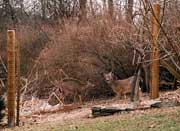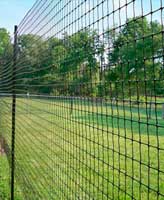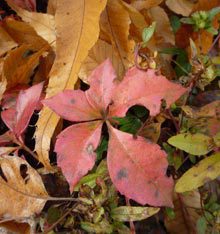Your Bambi Buster Guide to the Lowcountry
By Lanier Laney

Talk to any island gardener and you’ll most likely hear a sad tale (or more likely an angry rant) about the most recent marauding invasion of their gardens by a midnight band of ravenous munching machines. Better know as the White Tail Deer.
It’s hard to believe, but in 1900 there were almost no White Tailed Deer in South Carolina, having been hunted to near extinction for their furry coats. In fact the terms we use for money today – ‘bucks’ and ‘doe’ – came from this Victorian trade in skins. So from a population of only 500,000 nationally in 1900 to nearly 20,000,000 deer today, their numbers have exploded due to laws protecting them. And their natural predators, the Cougar and the Red Tailed Fox, are vastly reduced, leaving only hunters as our last protection from the uncontrolled growth of herds. With this amazing growth, the impact on native plants, agricultural and ornamental vegetation, has been profound. Deer love tender shoots to graze, so our modern gardens are perfect for their munching pleasure.
You all know the anti-deer remedies that are much talked about but don’t work: Human hair, Irish Spring Soap in nylon hose, etc. So lets not waste time; let’s just cut to the chase. A deer fence. Specifically, a UV-treated polypropylene black mesh one which will protect your vegetables and roses. Don’t settle for anything less than 8 ft. tall. They sell 7 ft. ones, but deer can jump 7 and a half feet. When installed, the light weight black mesh is nearly invisible from a distance. Installation is much easier and the costs of enclosing large areas is much less than with metal fences. The fences last 8 to 10 years. You can either use wooden posts, wrap the mesh around trees, or metal posts. The optimum span is 20 to 25 feet between posts and/or trees. Fence posts must be at least 11′ to 12′ feet tall and about 6″ in diameter. 4″x6″ posts are readily available locally, but you should not go with smaller dimensions as they will not hold up to wind. You will also need to paint the wooden posts black to make them ‘disappear’ visually. Steel fence posts can be gotten from local fencing or plumbing supply stores or by mail order. If your garden is going to be organic, then stick to steel or untreated wooden posts.
Since deer can push their noses under a fence, you’ll need to curve the fence outward at the bottom and push in a ground staple every 12 feet or so. You can make those from wire coat hangers or buy steel pins online. It’s recommended that you tie 12 inch long white streamers at a height of 4 feet, every 12 feet for just the first month or so, to let deer know there is a fence there. Especially at known trail points. This is to protect the fence more than the deer.
Your finished fence should be taut and completely enclose the area with no openings. Some people take steel wire, or plastic covered steel wire sold as clothesline, and attach it to the tops of the posts and weave it in and out of the top of the fence to give a more finished look and protect it from falling branches. You can also do this at the bottom.
Benners Gardens is a great online source for polypropolene deer fencing supplies. They have packages for small gardens on up to 40 acre estates. (www.bennersgardens.com ) The new organic garden at Habersham was enclosed by polypropylene fencing ordered from Benners. I was told that the cost of surrounding the entire acre with 8 ft fencing plus wooden posts was about $1,200. Benners has a full small garden kit, posts, fencing, all you need on sale for $333.00. I have seen a 100 foot roll of the 7.5 mesh fencing without posts etc. for sale online for as low as $120.00. The 7 ft. tall ones are even less. But again, remember that deer can jump 7 and a half feet. They also advertise Deer ‘netting’ for as low as $24.99 per 100 ft. roll. But I’m guessing that ‘netting’ is not the same strength as the polypropylene ‘mesh’. Be sure and read the fine print and get exactly what you want when ordering.
If you want to spend a few more ‘bucks’ for a longer term solution (up to 30 years) another way to go is metal hexagrid deer fence, which is essentially sturdy 20-gauge chicken-wire with a 1-inch mesh that has received a UV-resistant black pvc coating, which adds to its life and reduces its visibility.
This is a great fence to end all deer penetrations. Less visible, longer lasting , and a great deal stronger than polypropylene deer fence, its lower reaches are invulnerable to woodchucks, rabbits, and deer. The McGregor Fence company has this product online and also sells gates. www.invisible-deer-fence.com
If you don’t want to use fencing at all, I’ve heard good things about Contech Electronics Scarecrow Motion-Activated Sprinkler which you can buy online. It’s battery operated and fires a warning burst at anything that moves including cats, rabbits, dogs, and even the mailman. You have to have a way to turn it off or approach from behind otherwise you will become the target in your own garden. I believe Havahart has a version also.
Several new sonic and ultra-sonic devices are now on the market. The sonic ones emit everything from whistles to the sound of dogs barking. And the ultra sonic ones aren’t audible to the human ear. www.deerbusters.com has one called Deer Chaser, along with several others.
In the category of granular repellants, I’m told one of the best one is Deer Scram (www.deerscram.com ). Their website says it gives 100% protection. Which is kind of a mighty big claim. (I hope they are right). I’ve heard that the following sprays give from 95-98% protection: Deer Off – Protects two ways, by odor (from putrescent whole egg solids) and by taste (from capsaicin and garlic). OMRI certified organic. Dries clear. Plantskydd – Bloodmeal based; longest lasting over winter. Adds trace amounts of nitrogen to soil. (Avoid overspray on white siding or sidewalks and expect a slight pink tint on white blooms for a few days.) I Must Garden – A minty blend of oils that release their potency over time for extended protection. Beneficial side effect: helps control insects. Lowest cost per ounce.
Each deer can eat 5 to 10 pounds of greens per night. And no plants are immune from being eaten. But some can be less tasty to deer and thus are labeled ‘Deer Resistant Plants’. So as part of your overall strategy, you may want to google ‘Deer Resistant plants’ to find extensive lists online.
To name just a few deer supposedly don’t like: Boxwood, Birch trees, Scotch Pine, Douglas Fir, Privet, Purple Coneflower, Foxglove, Plumbago, Daffodil, Marigold, Nasturtium, Yucca.
Some plants they love to eat include: Leyland Cypress, Fringe Tree, Redbud, White pine, Saucer Magnolia, Pear, Quince, Oakleaf Hydrangea, Mountain Laural, Hybrid Roses, Blackberry, and Raspberry, Yew, Highbush Blueberry, Evergreen Azaleas, English Ivy, Sunflower, Hosta, Daylily, Geranium, Tulips, Periwinkle, Lily, Pansies, Violas, & Soybeans.
No column about deer repellent products would be complete without the prerequisite ‘nutty’ solution to getting rid of deer. Mine comes from a lady in Columbia who lives near the zoo. She claims the best deer deterrent in the world is tiger dung. Which kind of makes sense if the #1 historic deer predator is the Cougar. So next time the circus is in town, grab a shovel!
Hope some of this info helps you in your bambi busting days ahead!







